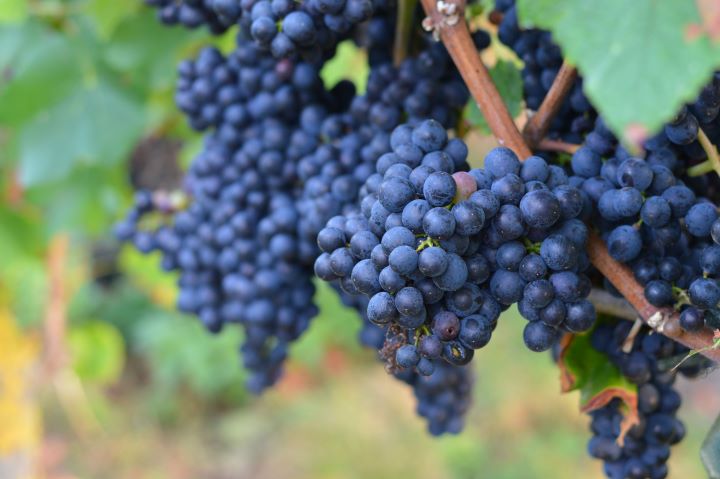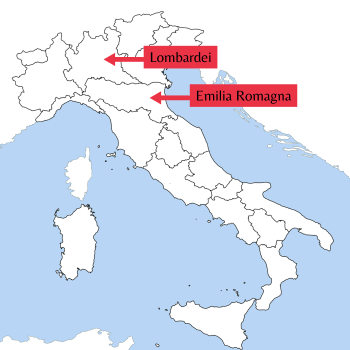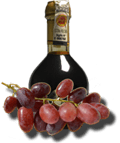It is the most famous wine of Italy: Lambrusco. Most people know it as a sweet wine from the Emilia-Romagna region of northern Italy, but there is so much more to the name Lambrusco. First and foremost, Lambrusco is a grape. It is used to produce the wine of the same name, which is known all over the world. But the Lambrusco grape can and does produce much more than just a sparkling red wine. Did you know that a major part of the balsamic vinegar is made from Lambrusco grapes?

What is Lambrusco?
Lambrusco is an old red grape variety. Actually, Lambrusco is not one kind of grape, but the name of a whole family, a group of about 60 varieties grown in Italy. The grape variety is so old that it was already mentioned by the writers of the ancient Roman world under the name of Lambrusca.
The cone-shaped clusters of Lambrusco grapes bear small, round, dark blue to black berries. Lambrusco vines are very hardy and thrive in soils that are not too rich and dry. This means that they can withstand even the most adverse climatic conditions. The Lambrusco grape ripens very late in the year, so that it can absorb the autumn sun and become particularly sweet. The harvest takes place every year between September and November. Another characteristic that has made Lambrusco so successful is that it is particularly productive.
The classic: Lambrusco as a wine
Thinking that only red wine can be made from Lambrusco is a misconception. Rose wines, sparkling wines and even white wines are also produced from this grape. Though mostly sweet, it can also be dry. After pressing, the juice is not very colourful. Because of its paleness, it is often blended with so-called colouring grapes such as Ancelotta or Rossissimo to obtain a darker colour for red wines.
Because the Lambrusco vines are particularly productive, in the 60s and 70s the wine market was flooded. In the United States alone, 3 million cases of Lambrusco were sold each year, which contributed to the fame of Lambrusco as a wine. Today Lambrusco is still the most exported wine in the world.
However, the high volume of sales has had a negative impact on its image. For a long time, Lambrusco was considered an inferior, sweet sparkling wine that was even bottled in cans in the 1980s. Although the image of a mass product still persists, it has improved and even high quality wines are once again associated with a Lambrusco. Much of this has been helped by the work of the Consorzio Tutela Lambrusco. Similar to the Consortia for the Protection of Aceto Balsamico, there has been a recognised inter-professional non-profit association responsible for the control and protection of Lambrusco since the 1st of January 2021. It is also responsible for promoting and disseminating the image of the wines.
The unknown: Lambrusco as balsamic vinegar
Few people know that the Lambrusco grape is an essential element in the production of Aceto Balsamico di Modena. For a balsamic vinegar to be called "Aceto Balsamico di Modena Tradizionale", only seven different grape varieties from Emilia-Romagna can be used. These are Ancellotta, Berzemino, Sauvignon blanc, Sgavetta, Occio di Gatta, Trebbiano and Lambrusco. Much of the balsamico produced in Modena and Reggio Emilia is made from the latter two. Along with Trebbiano, Lambrusco is one of the most important grapes used in the production of Aceto Balsamico.
Where is Lambrusco grown?

Lambrusco is mainly planted in the Emilia-Romagna region, but it can also be produced in Lombardy, South Tyrol, Piedmont, Puglia, Basilicata and Sicily. In Emilia-Romagna there are four protected areas of origin: Lambrusco di Sorbara, Lambrusco Grasparossa di Castelvetro, Lambrusco Reggiano and Lambrusco Salamino di Sante Croce. Outside the region of Emilia-Romagna there is the Lambrusco Mantovana from Lombardy, whose area of origin is also protected:
- Lambrusco di Sorbara: The region is located to the north of Modena. The phenomenon of small berries (when the grape, in addition to the normally developed berries, also has berries that remain small due to an anomaly in flowering) gives Lambrusco di Sorbara its high quality. This is the characteristic that distinguishes it from other Lambruschi. The yield is always moderate and in some years very low. However, these small quantities are compensated by the highest quality. It has a pleasant acidity.
- Lambrusco Grasparossa: The area is located to the south of Modena. Lambrusco Grasparossa is an Italian grape variety that has adapted very well to the hilly landscape with its clay and limestone soils. This Emilian grape variety found mainly in the Castelvetro area and ripens relatively late: in the past it was not harvested until the beginning of November, sometimes even later. The grape is rich in tannins and has a certain sweetness.
- Lambrusco Salamino di Santa Croce: Lambrusco Salamino originates from the Carpi area in the north-western part of the province of Modena to the lowlands around Modena. It is a high-yielding grape variety with a very dense and cylindrical bunch. Salamino is mainly harvested at the end of September and is very sweet.
- Lambrusco Reggiano: The most important area in terms of quantity is located to the west of the city of Modena. Lambrusco Reggiano is the largest Lambrusca production area. The particularity of Reggiano is that it is made from several varieties of grapes.
- Lambrusco Mantovano in Lombardy: Lambrusco Mantovano in the area along the Po River south of Mantua in Lombardy is the only protected area outside Emilia-Romagna.


Cooking with Traditional Balsamic Vinegar
Meesha Halm, 96 pages
$ (EN) 18,90
Order today!